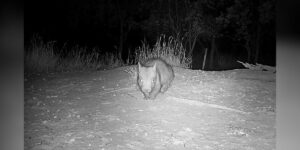
Man Is Ecstatic To Catch One Of Australia’s Rarest Animals Hidden Camera
Waddling across the shrub-filled woodlands of Australia’s Richard Underwood Nature Refuge, a stout animal with perky ears stopped for a moment, sniffing around the dirt and sticks.
Little did the animal know it, but he’d just wandered into the watchful lens of a hidden camera. For the animal, this night proved nothing out of the ordinary. But for the team of researchers poring over the footage, the moment felt remarkable.
“Ecologists at Australian Wildlife Conservancy (AWC) were ecstatic,” AWC wrote in a press release. “With only 400 individuals remaining in the world, every single wombat sighting counts.”
The animal wasn’t just any wombat — he was a northern hairy-nosed wombat, a critically endangered species. According to AWC, these animals are the largest of all Australian wombats, making them the biggest burrowing marsupials in the world.

Once more common, northern hairy-nosed wombat numbers slowly decreased due to predation, competition with other species and habitat destruction. Now, according to AWC, these distinctive wombats are one of Australia’s rarest mammals.
Protecting these unique wombats is crucial — not just for the Australians who appreciate them, but also for the rich natural ecosystem relying on their role in the environment. That’s why AWC continues to protect northern hairy-nosed wombat populations across multiple national parks and state forests.

Senior field ecologist Andy Howe first recorded the sighting while sifting through over 100 hours of footage. Stumbling on the wombat, Howe almost couldn’t believe his eyes. The researcher felt elated to see such a rare animal thriving in the wild. He’s hopeful that this sighting is a positive sign for the wombats’ continued success.
“It’s very gratifying to know that one of the world’s most critically endangered animals is doing well and breeding within the safety of the fenced area,” Howe said in a press release. “Although this isn’t the first joey born at the refuge, it is the first juvenile spotted for a few years. Knowing the work we at AWC are doing is actively contributing to the recovery of this species really warms the heart.”



